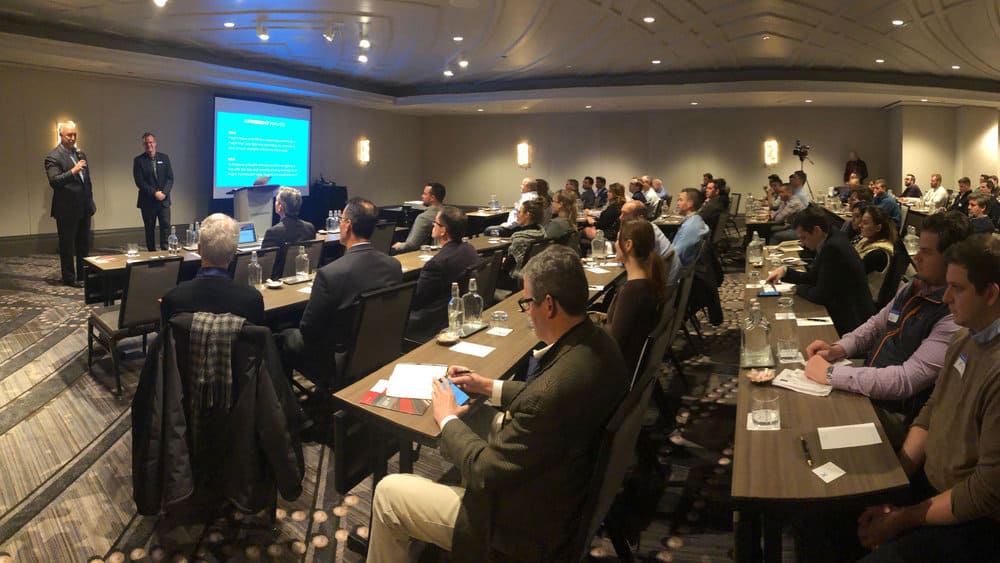
Some $726 billion in annual spend on U.S. surface transportation faces daily price swings, but futures aim to mitigates the volatility.
Pity the transportation purchasing manager. Since the demise of the Motor Carrier Act of 1980, executives in charge of procuring truck transportation face fast-changing freight rates every day. When millions of dollars in transportation spend face that volatility, it’s no wonder that many in the industry looked for ways to de-risk those price swings.
“Managing $150 million to $250 million in purchased transportation budget was very, very difficult,” said Michael Vincent, executive vice president of commercial solutions at FreightWaves. “Hitting those budgets throughout the changes in the year was even more difficult.”
George Abernathy, former president of third-party logistics provider Transplace and now chief revenue officer of FreightWaves, echoed the view that while managing billions in freight spending, “if I had the opportunity to de-risk any portion of that, I would have done so.”
Vincent and Abernathy were speaking in Chicago before an audience of about 60 transportation and finance professionals on the new Trucking Freight Futures that are launching on March 29.
FreightWaves, alongside industry partners DAT Solutions and Nodal Exchange, will introduce the first financially settled futures product based on dry van rates for seven major freight lanes in the U.S.
After 30 years in the logistics business managing rate volatility, Vincent “jumped at the chance [to offer a product] that de-risks the volatility that we experienced in our former lives.”
Many in the Chicago audience know the volatility in trucking rates very well.
DAT’s Chicago-to-Atlanta dry van rate index, which has a 90-day moving average of $2.24 per mile, has one standard deviation of roughly $0.17 per mile, a move of roughly 7 percent.
Dry van freight rates have moved one standard deviation or higher in 29 of the last 90 days. (SONAR: DATVF.CHIATL)

Vincent compared the change from fixed truck tariffs to a spot-rate driven market to the end of price controls on U.S. crude oil in 1981 and the subsequent introduction of the first crude oil futures contract in 1983. There are now about 1.2 million crude oil futures contracts traded per day, each representing 1,000 barrels of oil.
“The demand to de-risk that spot rate price volatility brought in freight miles as a commodity to be traded,” Vincent said.
By way of comparison, truckers log about 40 billion miles in the spot market annually. Each trucking freight futures contract represents 1,000 of those miles.
Those spot miles are an increasing risk for a number of companies. Kyle Lintner, Director of Markets at K-Ratio, said 40 percent of S&P 500 companies reported that transportation costs as hurting profitability.
“That is a huge amount,” Lintner said. “It’s a significant problem going forward.”
Just as daily price swings for crude oil are driven by a host of geo-political and economic factors, trucking spot rates are also driven by “government regulation, the ELD mandate, the fear of tariffs being imposed on containers shipped to the U.S., weather, and road conditions,” Vincent said.
While those outside forces buffet trucking, telematics and mobile phone technology provide greater visibility into truck supply and demand, Vincent explained, allowing industry players to better understand how rates move.
In ways never before possible, “We have direct contact with drivers, know exactly what’s happening on the ground, know the loads and when they are moving,” Vincent said.
Of course, the viability of a futures contract is only as good as the legitimacy of the prices that underlie it. DAT compiles spot rates from 700 different sources, including almost all of the top 100 freight brokers in the U.S., capturing $60 billion in spot freight spending each year.
Nodal Exchange, part of the EEX Group, provides the other leg for the contract to stand on by standardizing terms, creating forward price curves, providing the trading platform and contract clearing. These factors remove the risk that a counterparty may not be able to fulfill its side of the contract.
The exchange is “really the buyer and seller for every transaction,” said Danny Gomez, senior director of energy markets at Nodal Exchange. “You are never really the party on the other side.”











